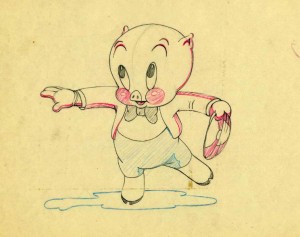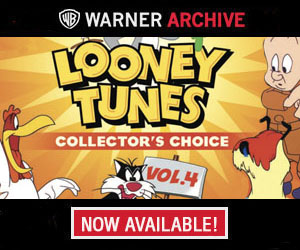
“You don’t know why you should learn the Pledge of Allegiance to the Flag?”
So says Uncle Sam to Porky Pig, after which Uncle Sam then provides an American history lesson to show Porky why it’s so important, in Warner Bros. 1939, Merrie Melodies short, Old Glory.
 Directed by Chuck Jones (credited as Charles M. Jones) with animation by Robert McKimson and musical direction by Carl Stalling, Old Glory celebrates its 85th anniversary this year.
Directed by Chuck Jones (credited as Charles M. Jones) with animation by Robert McKimson and musical direction by Carl Stalling, Old Glory celebrates its 85th anniversary this year.
In his book, That’s All Folks: The Art of Warner Bros. Animation, author Steve Schneider notes that the short “…was commissioned by Warner Bros. as a counterpart to a series of live-action shorts dealing with American history and patriotism.”
Old Glory opens with a shot of the American flag billowing in the wind. As the camera tracks down the flagpole, we see Porky Pig lying at the base, with a book open and attempting to learn the Pledge of Allegiance.
Porky’s stutter gets in the way, and he eventually gets so frustrated he throws his U.S. History book and says, “I don’t see why I need to learn the old Pledge of Allegiance anyhow!”
Porky then falls asleep and, in his dream, Uncle Sam appears and proceeds to tell Porky why he needs to learn the Pledge by providing a tutorial in U.S. History, taking Porky and the audience through Colonial America, the Midnight Ride of Paul Revere, the American Revolutionary War, the expansion of the Old West and the words of Abraham Lincoln.
 Martha Sigall, a painter at Warner Bros at this time, discussed Old Glory in her book Living Life Inside the Lines: Tales from the Golden Age of Animation.
Martha Sigall, a painter at Warner Bros at this time, discussed Old Glory in her book Living Life Inside the Lines: Tales from the Golden Age of Animation.
Sigall noted that bringing American history to life in animation for Old Glory involved rotoscoping, a process in which animators trace over live-action motion picture footage, frame by frame, to assist with producing more realistic movement.
“Quite a bit of the animation was rotoscoped from a 1938 Warner Bros. live-action short titled The Declaration of Independence,” wrote Sigall in her book.
As a painter, the short presented a challenge for Sigall and that team, as she noted: “The thing that made this one cartoon different from all those done previously was that so many different tones of colored inks were used to produce shadows. For example, Uncle Sam had different shades on his hat, his beard, his face, and his clothes.”
 Also, in her book, Sigall recalled the challenges of producing Old Glory during a heat wave that hit Los Angeles at the time, and with no air conditioning, temperatures in the studio went over one hundred degrees. Fans were brought in, but they blew drawings and cels around.
Also, in her book, Sigall recalled the challenges of producing Old Glory during a heat wave that hit Los Angeles at the time, and with no air conditioning, temperatures in the studio went over one hundred degrees. Fans were brought in, but they blew drawings and cels around.
“It was decided that we would work at night until the heat wave passed,” wrote Sigall. “The temperature dropped about ten degrees at night, and we were, somehow, able to finish the picture.”
The voice talents at the opening of Old Glory aren’t credited, but the book Looney Tunes and Merrie Melodies: A Complete Illustrated Guide to the Warner Bros. Cartoons by Jerry Beck and Will Friedwald notes that actor John Deering is the voice of Uncle Sam. Several sites, such as IMDb note that Mel Blanc provided Porky’s voice.
Years after its initial run, Schneider noted in his book that Old Glory found a new audience “…at New York’s Fillmore East Rock Concert House, where it would be screened between acts.”
The short would also find new life when TV stations would air Old Glory for the 4th of July, as the Warner Bros. Cartoons came to television, according to Charles Gardner, in his 2020 Cartoon Research piece, “A Revolutionary Article (Part 1)”.
In that article, Gardner calls Old Glory, what many consider it today: “the granddaddy of all patriotic cartoons.”
Watch the film below.


 Michael Lyons is a freelance writer, specializing in film, television, and pop culture. He is the author of the book, Drawn to Greatness: Disney’s Animation Renaissance, which chronicles the amazing growth at the Disney animation studio in the 1990s. In addition to Animation Scoop and Cartoon Research, he has contributed to Remind Magazine, Cinefantastique, Animation World Network and Disney Magazine. He also writes a blog, Screen Saver: A Retro Review of TV Shows and Movies of Yesteryear and his interviews with a number of animation legends have been featured in several volumes of the books, Walt’s People. You can visit Michael’s web site Words From Lyons at:
Michael Lyons is a freelance writer, specializing in film, television, and pop culture. He is the author of the book, Drawn to Greatness: Disney’s Animation Renaissance, which chronicles the amazing growth at the Disney animation studio in the 1990s. In addition to Animation Scoop and Cartoon Research, he has contributed to Remind Magazine, Cinefantastique, Animation World Network and Disney Magazine. He also writes a blog, Screen Saver: A Retro Review of TV Shows and Movies of Yesteryear and his interviews with a number of animation legends have been featured in several volumes of the books, Walt’s People. You can visit Michael’s web site Words From Lyons at: 






















One could certainly write several pages about the content of this short; personally, whatever one could say about the storytelling of “Old Glory”, I just love the use of color. while not one of my favorite Looney Tunes shorts, it’s an intriguing outlier i enjoy revisiting periodically.
Aside from the color, probably my favorite aspect of this short is how it’s very definitively dated, with its 48-star flag and its Pledge lacking the phrase “under God”.
Alaska and Hawaii didn’t become states until the 50’s, and Under God was added to the pledge decades after the short was released during the Cold War.
The closing of the cartoon was preserved despite being reissued as a Blue Ribbon too.
Two exhaustively-researched books on voice actors (using primary sources) have been written by Keith Scott, but we get quotes from “several sites” instead?
Nobody is credited on the available versions of the cartoon because they’re Blue Ribbons from a time when re-releases contained no credits. Film Daily‘s report on it referred to Chuck Jones, Bob McKimson, as well as Johnny Burton, Milt Franklyn, John W. Deering and the Paul Taylor vocalists by name; how many of them got screen credit is a guess.
Film Daily called the short “stirring entertainment” but a few other reviewers of the day yawned. Boxoffice said in its June 17, 1939 issue: “Probably the first animated capsule of Americanism handled in a manner which will make exhibitors wonder why they have to pay for it. It’s strictly flag waving and has only bits of fine cartoon work to recommend it.” Showmen’s Trade Review called it as “okay as propaganda.”
The Boxoffice reviewer must not have seen the trade ad posted above which said, “at no extra cost…”
Any cartoon book using primary sources is worth my money.
“Two exhaustively-researched books on voice actors (using primary sources) have been written by Keith Scott, but we get quotes from “several sites” instead?”
Well, who did you expect played Porky? Stan Freberg? Dick Van Dyke?
Would screen my 16mm print of this cartoon every 4th of July, in our backyard before going next door to watch the city’s fireworks off my neighbor’s deck. The kids never got tired of the fireworks but, alas, they were always asking for any other cartoon! Still have that print, the low fade color still looks great and I still love it.
It occurred to me that Carl Stalling’s score for “Old Glory” could stand alone as a concert piece, a medley/suite of patriotic songs, performed here magnificently by the full Warner Bros orchestra.
Peculiar rotoscoping, almost like Bakshi only without the funky colors. Until I saw this cartoon I never realized how much Patrick Henry resembled Patricia Neal. Clearly they were trying for an Oscar.
The scene of Patrick Henry was roto-traced from the “Give Me Liberty” short, where John Litel played Henry. (He also portrayed Thomas Jefferson in the “Declaration of Independence” short.) The Warners American-history shorts ran in schools for years, inaccurate as they were.
Not a favorite of mine; decent message, but dull. A cartoon doesn’t have to be funny to be good (as The Old Mill proves), but this was simply too preachy, too rotoscoped, too literal, too long, and too no-good.
Another Jones classic. (facepalm)
I thought the short was really well done and a nice early piece by Jones.
Harry Warner (J.L.’s brother) was very big on 100% Americanism stuff, and I’ll wager he loved this cartoon.
Happy 85th anniversary to “Old Glory”!